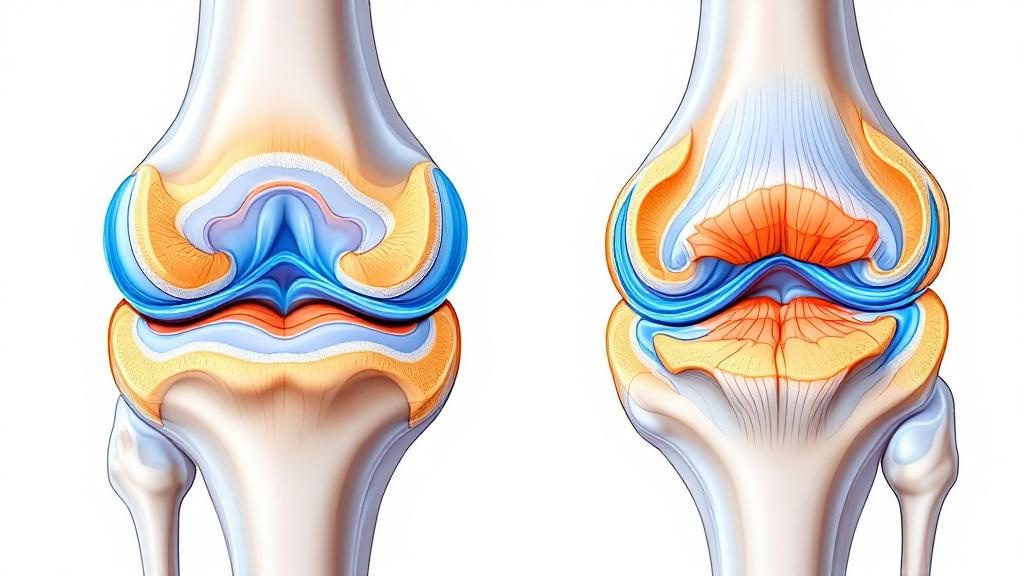When to Consider Regenerative Medicine Treatment
You've been coming in for adjustments. You're doing your exercises. You're staying consistent with care.
And things are better. You can feel it.
But there's this nagging thing that won't go away. That one spot that flares up no matter what you do. That injury that's improved but never fully healed. That chronic pain that keeps circling back even after weeks of progress.
Here's what most people don't realize: chiropractic care is incredibly powerful, but it's not designed to solve every problem your body throws at you.
Sometimes your body needs more than an adjustment to finish the job.
That doesn't mean chiropractic isn't working. It means you've hit the edge of what alignment and nervous system function can do on their own. And when that happens, it's time to bring in reinforcements.
This is where regenerative medicine enters the picture. It's not about replacing your chiropractic care. It's about giving your body the extra tools it needs when healing hits a wall.
So how do you know when you've reached that point? Let's talk about the signs.
You're Still in Pain After Months of Consistent Care

Let's be clear: healing takes time. Your body doesn't rebuild itself overnight, and expecting instant results from chiropractic care is setting yourself up for disappointment.
But there's a difference between "healing takes time" and "this isn't changing no matter what we do."
If you've been under consistent chiropractic care for three, six, or even twelve months and you're still dealing with the same pain levels, that's a sign something deeper is going on.
Chiropractic adjustments remove interference from your nervous system. They realign your spine. They restore motion to restricted joints. All of that helps your body heal more effectively.
But if the tissues themselves are damaged beyond what your body can naturally repair, adjustments alone won't close that gap.
Torn ligaments don't heal just because your spine is aligned. Damaged cartilage doesn't regenerate because your nervous system is functioning better. Chronic inflammation in tendons doesn't disappear just because the joint is moving correctly.
When structural damage is the root cause of your pain, your body needs more than improved function. It needs actual tissue repair.
And that's exactly what regenerative medicine is designed to do.
Understanding the Healing Plateau
Your body has an incredible ability to heal itself. But it also has limits.
When you first start chiropractic care, you'll usually see steady improvement. Pain decreases. Function improves. You feel better week after week.
Then you hit a plateau.
The progress stops. You're better than when you started, sure, but you're not 100%. And no matter how many adjustments you get, that last 20-30% just won't budge.
That plateau isn't a failure of chiropractic care. It's your body telling you it's done everything it can with the resources it has.
Think of it like this: if you're building a house and you run out of materials, it doesn't matter how good your construction crew is. The project stalls until you bring in more supplies.
Regenerative medicine delivers those supplies. It gives your body concentrated healing factors, growth signals, and cellular support that kickstart the repair process in tissues that have stalled out.
The Pain Keeps Coming Back

You get adjusted. You feel great for a few days. Then the pain creeps back in.
You get adjusted again. Relief returns. Then it fades.
This cycle repeats over and over, and you start to wonder if you're ever going to break through.
Here's what's happening: your adjustments are working, but the underlying tissue damage keeps pulling you back.
Imagine trying to drive a car with a flat tire. You can tune the engine, align the wheels, and optimize everything else, but as long as that tire is flat, the car's not running right.
That's what damaged tissue does. It creates ongoing dysfunction that your nervous system has to constantly compensate for.
Your adjustments are handling the compensation. They're keeping your body as functional as possible given the circumstances. But they're not fixing the flat tire.
When the same pain keeps returning despite consistent chiropractic care, it's a clear sign that the tissue itself needs attention.
Why Your Body Gets Stuck in Pain Cycles
Chronic pain isn't just about damage. It's about your body getting stuck in a loop.
When tissue is injured, your body triggers inflammation to start the healing process. That inflammation is supposed to be temporary—it does its job, then it goes away.
But when tissue damage is severe or chronic, inflammation doesn't shut off. It becomes part of the background noise in your body, constantly signaling that something's wrong.
Your nervous system adapts to this. It starts treating the pain as normal. Your brain rewires itself around the discomfort.
And even when you get adjusted and restore proper function, that inflammatory loop keeps running.
Regenerative medicine breaks the cycle. It addresses the tissue damage that's fueling the inflammation, gives your body what it needs to actually finish the repair process, and helps reset your pain signaling back to normal.
That's not something an adjustment can do on its own. It's a different tool for a different problem.
You're Dealing with Arthritis or Degenerative Changes

Arthritis and joint degeneration are brutal. They're slow, progressive, and they chip away at your quality of life one day at a time.
Chiropractic care helps manage the symptoms. Adjustments keep the joint moving, reduce compensatory stress on surrounding areas, and maintain as much function as possible.
But let's be honest: adjustments can't regenerate cartilage.
Once cartilage starts breaking down, your body struggles to rebuild it. The damage accumulates faster than your natural repair mechanisms can keep up.
You end up with bone-on-bone friction, chronic inflammation, and pain that limits everything you do.
This is one of the most common scenarios where people need more than chiropractic care. Not because chiropractic isn't valuable—it absolutely is—but because the problem isn't just mechanical. It's biological.
Your joints need new tissue. They need cellular support. They need growth factors and healing signals that tell your body to rebuild what's been lost.
That's where regenerative therapies like PRP and stem cell treatments come in. They deliver concentrated healing factors directly to the damaged joint, giving your body the tools it needs to slow degeneration and support repair.
The earlier you address this, the better. Waiting until the joint is completely destroyed limits what regenerative medicine can do. But catching it early? That can change the trajectory completely.
How Degeneration Outpaces Healing
Here's the thing about arthritis: your body is trying to heal the damage. It's just losing the race.
Every day, your joints are under stress. Walking, bending, lifting—normal activities all create wear and tear. In a healthy joint, your body repairs that damage overnight.
But when degeneration sets in, the damage starts accumulating faster than your body can fix it.
It's like trying to bail water out of a boat with a hole in the bottom. You're working hard, but the water's coming in faster than you can remove it.
Chiropractic care helps slow the accumulation of damage by keeping your joints moving properly and reducing compensatory stress. That's valuable. It buys you time and keeps you functional.
But it doesn't plug the hole.
Regenerative medicine does. It accelerates your body's repair rate, giving you a fighting chance to outpace the degeneration instead of just managing it.
Your Injury Happened Months (or Years) Ago and Never Fully Healed

Old injuries are tricky.
You hurt yourself years ago. Maybe you sprained an ankle, tore a ligament, or tweaked your back. It healed enough that you could function, so you moved on with life.
But it never healed completely.
Now, years later, that old injury is causing problems. The area is weak. It flares up when you push it. It's become a chronic weak spot that limits what you can do.
You start getting adjusted, and things improve. The pain decreases, the function gets better. But you can't shake the feeling that something's still not right.
That's because old injuries leave behind scar tissue, weakened structures, and incomplete repair.
Your body did the best it could at the time. But it didn't have everything it needed to fully restore the tissue. So it patched things together with whatever was available and called it good enough.
Adjustments help you work around that incomplete repair. They keep the area as functional as possible given the limitations.
But they don't undo years of suboptimal healing.
Regenerative medicine can. It goes back into that old injury site and restarts the repair process with the resources your body should have had in the first place.
It's never too late to finish what your body started.
Why Old Injuries Don't Just "Go Away"
People assume that if an injury doesn't hurt anymore, it's healed.
That's not how it works.
Your body has an incredible ability to adapt. When tissue is damaged and doesn't heal properly, your nervous system compensates. It redistributes stress, alters movement patterns, and works around the weakness.
You stop feeling the injury because your body has learned to avoid using it.
But the tissue itself? Still damaged. Still weak. Still a liability waiting to cause problems down the road.
This is why people "re-injure" the same spot over and over. It's not bad luck. It's incomplete healing finally catching up with them.
Chiropractic care helps manage the compensations and keeps your body functioning as well as possible. But if you want to actually address the underlying tissue damage, you need something that targets repair at the cellular level.
That's the role of regenerative medicine in old injuries. It's not about managing the compensation—it's about eliminating the need for it.
You're Trying to Avoid Surgery (But Conservative Care Isn't Cutting It)

Nobody wants surgery.
The recovery time. The risks. The cost. The fact that surgery doesn't always work.
So you try everything else first. Physical therapy. Chiropractic care. Injections. Medications.
And you get some relief. Things improve. But the problem doesn't go away.
Now you're stuck in this frustrating middle ground. Conservative care isn't solving the problem, but surgery feels like too much.
This is exactly where regenerative medicine shines.
It fills the gap between conservative care and surgery. It's more aggressive than adjustments or PT, but it's nowhere near as invasive as going under the knife.
For a lot of people, regenerative medicine is the missing option they didn't know existed.
You're not giving up on conservative care. You're adding a tool that addresses the structural damage conservative care can't touch.
And in many cases, that's enough to avoid surgery altogether.
The Gap Between Chiropractic and Surgery
The traditional healthcare model gives you two options: try conservative care, and if that doesn't work, get surgery.
There's no middle ground.
That's a huge problem, because most people don't need surgery. They just need something more than what conservative care can offer.
Chiropractic adjustments, physical therapy, and lifestyle changes are incredibly effective for functional problems. If the issue is alignment, movement patterns, or nervous system interference, those approaches work great.
But when the problem is damaged tissue—torn ligaments, degraded cartilage, chronic tendon injuries—conservative care hits a wall.
Surgery can address those problems, but it's overkill for most situations. It's expensive, risky, and forces you into months of recovery.
Regenerative medicine sits right in that gap. It addresses structural damage without cutting you open. It accelerates healing without the downtime of surgery.
And for a lot of people, it's exactly what their body needed all along.
What Happens Next?

If any of these signs sound familiar, you're not alone.
Thousands of people hit the limits of conservative care every year. It doesn't mean chiropractic isn't working. It means your body needs additional support to finish the healing process.
The good news? You don't have to choose between chiropractic and regenerative medicine. They work together. Your adjustments keep your nervous system functioning and your body aligned. Regenerative medicine gives your tissues the tools they need to repair.
When both are working in tandem, your body gets the full support it needs to actually heal—not just manage symptoms.
If you're dealing with chronic pain that won't resolve, old injuries that never fully healed, or degeneration that's limiting your life, it's worth exploring what regenerative medicine can do.
You can learn more about regenerative medicine and the options available right here in Sheridan at Regen and Restore. They specialize in helping people who need more than conservative care but want to avoid surgery.
And because they're in the same building as Atlas Chiropractic, your care stays coordinated. No bouncing between providers. No conflicting treatment plans. Just comprehensive care designed to get you back to living without limits.
You've already done the hard part by committing to your health. Now it's just about making sure your body has everything it needs to finish what it started.
Visit Regen and Restore to see if regenerative medicine is right for you.
Recent Blog Posts...
How Long Does Regenerative Medicine Take to Work?
Regenerative Medicine: A New Approach to Chronic Pain
Regenerative Medicine Options: PRP vs Stem Cells
When to Consider Regenerative Medicine Treatment
Living With Pain
Care of Concussions
Office Hours
2:00 PM - 5:30 PM
2:00 PM - 5:30 PM
Office Hours
2:00 PM - 5:30 PM
2:00 PM - 5:30 PM
Copyright 2025 | Atlas Chiropractic | All Rights Reserved | Website by iTech Valet






